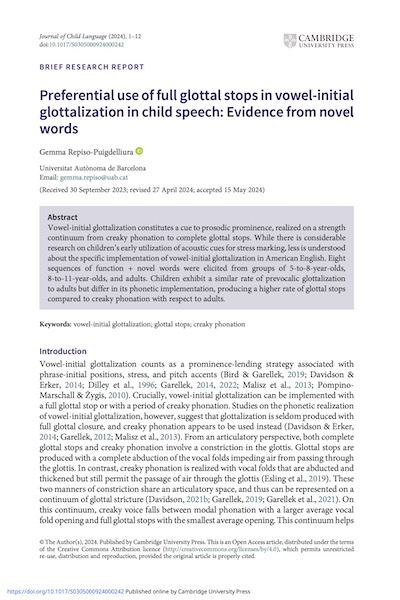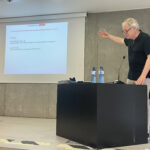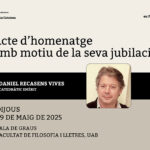3 octubre, 2024

Autors:
Gemma Repiso-Puigdelliura
Títol:
Preferential use of full glottal stops in vowel-initial glottalization in child speech: Evidence from novel wordsEditorial: Journal of Child Language (Cambridge University Press)
Data de publicació: 3 d'octubre 2024
Text completVowel-initial glottalization constitutes a cue to prosodic prominence, realized on a strength continuum from creaky phonation to complete glottal stops. While there is considerable research on children’s early utilization of acoustic cues for stress marking, less is understood about the specific implementation of vowel-initial glottalization in American English. Eight sequences of function + novel words were elicited from groups of 5-to-8-year-olds, 8-to-11-year-olds, and adults. Children exhibit a similar rate of prevocalic glottalization to adults but differ in its phonetic implementation, producing a higher rate of glottal stops compared to creaky phonation with respect to adults.
27 febrer, 2025

Autors:
Gemma Repiso-Puigdelliura
Títol:
Development of Vowel Intrusion in Spanish Heritage SpeakersEditorial: Language and Speech
Data de publicació: 27-02-2025
Més informacióThis study investigates the sound system of heritage speakers (henceforth, HSs) as they shift dominance from their heritage language to their majority language. Specifically, it analyzes the production of intrusive vowels in Spanish consonant clusters across the lifespan of HSs, focusing on tautosyllabic clusters (i.e., /Cɾ/) and heterosyllabic clusters (i.e., /ɾ.C/). Semi-spontaneous speech was elicited from three age groups of Spanish HSs—younger children, older children, and adults—for whom American English is the majority language, as well as from three age-matched groups of non-heritage Spanish speakers raised in Mexico. The presence and duration of intrusive vowels were examined, with the latter calculated as a ratio of intrusive vowel duration to tap duration. Overall, the results indicate that all speaker groups more frequently produce consonant clusters with intrusive vowels than without. However, Spanish HSs produced fewer and shorter intrusive vowels compared with their non-heritage counterparts. In addition, heritage and non-heritage speakers exhibited a lower rate of intrusive vowel production in the 5-to-8 -year-old group compared with adults. Despite this, the absence of an interaction between age group and speaker type suggests a parallel pattern of change in intrusive vowel production across all ages. Voicing emerged as the most consistent phonetic factor, predicting a higher rate of intrusive vowels with a longer duration relative to the tap.






